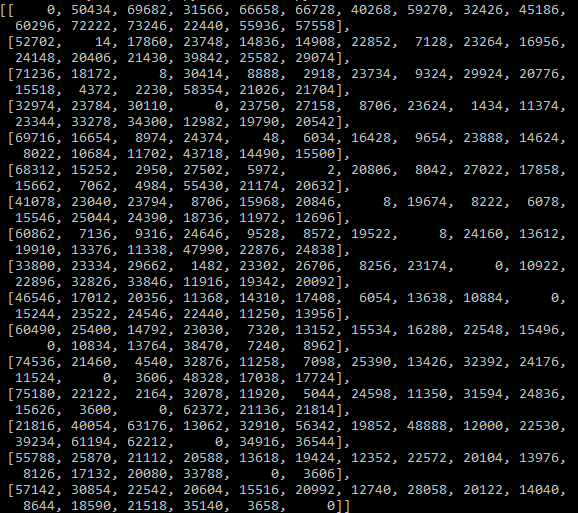Import distance matrix from CSV
1,093 views
Skip to first unread message
Bryan Salazar López
Mar 2, 2021, 8:48:29 PM3/2/21
to or-tools-discuss
Hi guys, I'm new to this group and I really don't know how I've progressed in building my model, since I'm an Industrial Engineer and I'm not proficient in Python.
I have managed to build the script that imports the distance matrix from "Distance Matrix API" and then operates them by multiplying matrices and scalars, transforming a matrix of distances and a matrix of times, into a matrix resulting in costs.
This cost matrix I can export in multiple formats: txt / csv, and of course it is a variable from my script.
I have not succeeded in getting the script that contains the Or-tools model to import the matrix from the script that generates the cost matrix. However, as I have mentioned, I have the csv and txt files.
Can you help me in the structure of the model in Python that imports a csv file as the distance matrix of the Or-tools model?
I would greatly appreciate your collaboration, this optimization module is part of a project to analyze the process of generating biodiesel from used cooking oil.
Madushan Fernando
Mar 2, 2021, 8:58:05 PM3/2/21
to or-tools...@googlegroups.com
Hi Bryan,
I used the following python code to import data from CSV and create the nested matrix. Then input that matrix as distance matrix.
import pandas
##Import CSV##
pandas.set_option('expand_frame_repr', False)
df = pandas.read_csv(r'C:\Users\User\Desktop\My working\Distance.csv')
print(df)
##Dataframe to list##
Matrix= df["Distance"].tolist()
print(Matrix)
##Convert into nested List##
i=0
new_list=[]
while i<len(Matrix):
new_list.append(Matrix[i:i+12])
i+=12
print(new_list)
--
You received this message because you are subscribed to the Google Groups "or-tools-discuss" group.
To unsubscribe from this group and stop receiving emails from it, send an email to or-tools-discu...@googlegroups.com.
To view this discussion on the web visit https://groups.google.com/d/msgid/or-tools-discuss/78eaae49-fac1-49cc-b3c9-2446eaa568den%40googlegroups.com.
Bryan Salazar López
Mar 2, 2021, 9:18:56 PM3/2/21
to or-tools-discuss
Hello, I appreciate your answer, I do not know if you could observe my .csv
I don't know if your code applies to my format, since the matrix is practically built
In fact, I'm going to show you the output I have from my D_matrix.py file:

This output is named as variable F in my script.
How can I invoke it from the optimizer script? I see that it is in the precise format that Or-tools requires
Or, How can I import my .csv in the format I attached above?
Madushan Fernando
Mar 2, 2021, 9:34:59 PM3/2/21
to or-tools...@googlegroups.com
I imported data from the following CSV and it contains a distances data frame.
To view this discussion on the web visit https://groups.google.com/d/msgid/or-tools-discuss/b57740cd-6ac3-40c4-9189-2f72cfa90bafn%40googlegroups.com.
Bryan Salazar López
Mar 2, 2021, 9:46:24 PM3/2/21
to or-tools-discuss
Now I understand your code a bit. No, I already have my csv in matrix form


An n x m matrix, where n = m
sirinebe...@gmail.com
Oct 5, 2021, 7:18:04 AM10/5/21
to or-tools-discuss
Which is the feasible Dataframe or dictionary? I import data from csv file after i convert to dictionary data. it read correctly

But, the code of TSP displays the distance = 0
Bryan Salazar López
Oct 5, 2021, 12:40:15 PM10/5/21
to or-tools-discuss
It has worked like this for me (VRP):
def matrix_distance():
matrix = np.genfromtxt('distance_matrix.csv', delimiter=';')
return matrix
def create_data_model():
"""Stores the data for the problem."""
data['distance_matrix'] = matrix_distance()
data['vehicle_capacities'] = vehiculos_capacidad
vehiculos_numero = len(data['vehicle_capacities'])
data['num_vehicles'] = vehiculos_numero
data['penalties'] = penalty
data['depot'] = 0
return data
def distance_callback(from_index, to_index):
# Convert from routing variable Index to distance matrix NodeIndex.
from_node = manager.IndexToNode(from_index)
to_node = manager.IndexToNode(to_index)
return data['distance_matrix'][from_node][to_node]
distance_callback_index = routing.RegisterTransitCallback(distance_callback)
Sirine Belguith
Oct 5, 2021, 3:22:00 PM10/5/21
to or-tools...@googlegroups.com
Thanks Bryan.
it returns the distance of the route and objectives =0.

Below is my code:
def matrix_distance():
matrix = np.genfromtxt('vehicle (2).csv', delimiter=';')
return matrix
def create_data_model():
"""Stores the data for the problem."""
data = {}
data['distance_matrix'] = matrix_distance()
data['num_vehicles'] = 1
data['depot'] = 0
return data
def print_solution(data, manager, routing, solution):
"""Prints solution on console."""
print(f'Objective: {solution.ObjectiveValue()}')
max_route_distance = 0
print(len(data['distance_matrix']))
for vehicle_id in range(data['num_vehicles']):
index = routing.Start(vehicle_id)
plan_output = 'Route for vehicle {}:\n'.format(vehicle_id)
route_distance = 0
while not routing.IsEnd(index):
plan_output += ' {} -> '.format(manager.IndexToNode(index))
previous_index = index
index = solution.Value(routing.NextVar(index))
route_distance += routing.GetArcCostForVehicle(
previous_index, index, vehicle_id)
plan_output += '{}\n'.format(manager.IndexToNode(index))
plan_output += 'Distance of the route: {}m\n'.format(route_distance)
print(plan_output)
#{print(index)
max_route_distance = max(route_distance, max_route_distance)
print('Maximum of the route distances: {}m'.format(max_route_distance))
def main():
"""Entry point of the program."""
# Instantiate the data problem.
data = create_data_model()
# Create the routing index manager.
manager = pywrapcp.RoutingIndexManager(len(data['distance_matrix']),
data['num_vehicles'], data['depot'])
# Create Routing Model.
routing = pywrapcp.RoutingModel(manager)
# Create and register a transit callback.
def distance_callback(from_index, to_index):
"""Returns the distance between the two nodes."""
# Convert from routing variable Index to distance matrix NodeIndex.
from_node = manager.IndexToNode(from_index)
to_node = manager.IndexToNode(to_index)
return data['distance_matrix'][from_node][to_node]
transit_callback_index = routing.RegisterTransitCallback(distance_callback)
# Define cost of each arc.
routing.SetArcCostEvaluatorOfAllVehicles(transit_callback_index)
# Add Distance constraint.
dimension_name = 'Distance'
routing.AddDimension(
transit_callback_index,
0, # no slack
3000, # vehicle maximum travel distance
True, # start cumul to zero
dimension_name)
distance_dimension = routing.GetDimensionOrDie(dimension_name)
distance_dimension.SetGlobalSpanCostCoefficient(100)
# Setting first solution heuristic.
search_parameters = pywrapcp.DefaultRoutingSearchParameters()
search_parameters.first_solution_strategy = (
routing_enums_pb2.FirstSolutionStrategy.PATH_CHEAPEST_ARC)
# Solve the problem.
solution = routing.SolveWithParameters(search_parameters)
# Print solution on console.
if solution:
print_solution(data, manager, routing, solution)
else:
print('No solution found !')
if __name__ == '__main__':
main()
To view this discussion on the web visit https://groups.google.com/d/msgid/or-tools-discuss/51ee3708-71c4-42f5-889b-8d59953a2503n%40googlegroups.com.
Reply all
Reply to author
Forward
0 new messages
